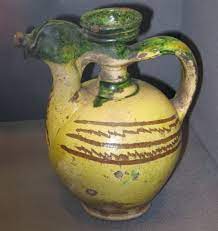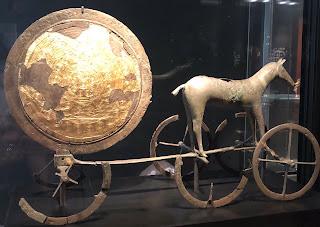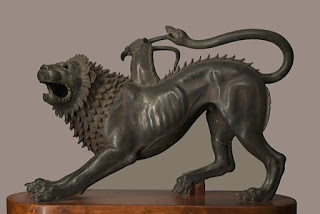Here are some very interesting metal plaques from the so called "Letnitsa Treasure", a 4th c. BC Thracian hoard discovered near Letnitsa, Bulgaria...
This one depicts one of the most common themes from Balkan fairytales: a princess being kidnapped by a dragon...

What happens next in Balkan fairytales is that a prince goes looking for the princess to rescue her. There are several metal plaques in the "Letnitsa Treasure" depicting a mounted warrior, like this one for instance...

Eventually, the prince finds the princess, living quite surprisingly, not unhappily, with the dragon...

What happens next in Balkan fairytales is that the prince manages to persuade the princess to help him defeat the dragon, by tricking the dragon into revealing his weakness...Dragon killed, princess saved, everyone happy. Particularly the princess who is sitting on the prince's laps with his hand up her skirt 🙂...As depicted on this last plaque from the "Letnitsa Treasure"...
Now how do we know that this is a dragon? It looks more like giant snake...With a crown...
Slavic folk tradition related to snakes, which consists of huge number of beliefs, taboos and rituals, is one of the most interesting and most complex in the world. And extremely old...
In Slavic mythology snake is closely connected to two mythological creatures: the Snake King and the Dragon...
And actually the only way to understand the meaning of the beliefs and rituals related to snakes is to look at them in correlation with beliefs related to the Snake King and the Dragon. And the other way round...
The snake king is an old male snake which wears a crown or a jewel on his forehead and usually guards a treasure...And sacred knowledge...

Like "Nemušti jezik" from Serbian folk tales. A language that a man can use to communicate with all living creatures in the world. You can't learn this language. You can only get the knowledge of this language if a Snake king spits into your mouth...
I talked about this in my posts "Glaucos" and "Kassandra"...
It was also believed that the Snake king commanded all the other snakes and told told them who to bite and kill...
Slavs recognized male and female snakes and actually have different words for male and female snakes. Female snake is called "zmija, zmeja"... while male snake is normally called "smuk, smok"... They were believed to be husband and wife or brother and sister...
What is interesting is that "smuk, smok" is another word for dragon, besides the most common word "zmaj, zmej", which is the masculine form of the word for snake "zmija, zmeja". In Slavic mythology dragon is believed to be an "old male snake"...
This is very interesting as it shows direct link between snakes and dragons and shows that Slavs believed that dragons were actually male snakes.
Slavs also believed that snakes were directly linked to the sun and that they fed off the sun's heat...I talked about this in my post "Enemy of the sun"...

In Poland, people believed that Snake king lives among the roots of an old Hazel tree. Every autumn he gathers all the snakes, who then slither up the tree to its branches "to see the sun for the last time" before they go under ground...

Snakes are solar animals. They are in our world when sun is in our world (hot part of the year) and they are in the underworld when sun is in the underworld (cold part of the year)...I talked about this in my post "The chthonic animal"
Snakes are symbol of the sun and the sun's heat. They are also symbols of the beginning of summer, as vipers, the most common Eurasian snakes, start mating in Apr/May, beginning of summer...
And dragons, old snakes, are symbol of the old sun, destructive summer sun which burns the land and causes drought. Steals and guards water...Which is why in Slavic mythology, dragon, always breathes fire...

And which is why in the past, during spring droughts, Serbs used to go to mountain lakes, on St George's day, and pray for rain on lake shores "to the dragons living in the lake who swallowed the rain"...
I talked about this in my post "Dragon who stole rain"...
There is actually a Serbian belief that "a snake got wings when it lived over 100 years, after which it flew away to live in lakes and waters"...Just like a Dragon...
This is in addition to the belief from Ukraine and Poland that snakes once had wings and flew in the sky. But the sun burned their wings and they fell on the ground. I wrote about this in my article about Slavic belief in the link between snakes and sun...
Now, there is an interesting Slavic word "jar" which means young, green, spring...It is the root of the name of the Slavic sun god, Jarilo (pronounced Yahreeloh)...He is the life giving spring and early summer sun that brings back life to the frozen earth...Here is a depiction of Jarilo painted by Russian artist Andrey Shishkin...

Jarilo is the original Green Man...This is Zeleni Jura (Green Jarilo) walking the earth. Part of Jurjevanje, celebration of the spring return of Jarilo, Sun god, from the land of the dead...Bela Krajina, area inhabited by descendants of Serbians who migrated here during Turkish invasions of the Balkans. Today split between Croatia/Slovenia...

But the root "jar" can also mean "brightly burning" and "raging, furious"...
This means that Jarilo can also mean "The Scorcher", the life destroying burning sun of the late summer and early autumn...
Two suns, young and old, the life creator and life destroyer...In one...
Jurjevo, the celebration of the return of Jarilo, is today known as St George's day. St George is basically Christianised Jarilo...
Jurjevo is the celebration of the beginning of the summer, the domain of the sun...And dragons...Because as the summer goes on, and the sun gets hotter and hotter, snake, the symbol of sun's heat, grows older and older and eventually turns into dragon, the symbol of destructive sun's heat...
Jarilo, The Scorcher, The Dragon...To whom Serbs, sacrificed rams during droughts, on St George's day, with blood poured into the lake, for the dragon who stole rain...
Funny...
St George = Jarilo = Dragon...
By the way, Serbs believed that the Snake King, who is "An Old Male snake", The Dragon, also had a "green branch in his mouth"...
Interesting right?
Snake King = Dragon = Jarilo = Green man...
By the way, the dragons who steal princesses in the Balkan fairytales usually live in palaces...They are kings...Snake kings...
I believe that Jurjevo, Jarilo's day, is at the same time the celebration of good spring sun and bad summer sun. The day of thanks for the spring and prayers for the summer...Anyway, on that day spring ends, summer begins...
And every year, on The Day of Jarilo, The Day of Dragon, the Young Spring Earth, Vesna, is "sacrificed" to the Young Sun, Jarilo (The Dragon). Spring (the princess) is "sacrificed" (it ends) so that Summer (The Dragon) can begin???
But wait, St George is a dragon killer!!! Well, what's the best way to Christianise Jarilo, The Sun, The Scorcher, The Dragon, than to turn it into it's opposite...The Dragon Killer...

Anyway, as I said, in AD Balkan Slavic fairytales, prince kills the dragon, gets the girl and lives with her happily ever after...Any BC myths like these?
BTW, this link between sun, snakes and dragons from Slavic mythology allows us to decipher meaning of snakes and dragons from other mythologies too...They are animal calendar markers. Snake is the animal calendar marker for the beginning of summer (Apr/May), when Eurasian snakes begin to mate. And dragon, the old snake, which was sometimes depicted as a lion with snake head(s), is the animal calendar marker for the end of summer (Jul/Aug), when Eurasian lions begin to mate, and snakes get old...
You can read more about snakes, dragons and lions in my posts "You will trample great lion and serpent", "Chimera", "Lion killing snake", "Jörmungandr", "Bactrian snakes and dragons", "Seven headed dragon", "Khafajeh vase", "Nude winged hero dominating snakes", "Winged superhuman hero", "Tiger and dragon", "Eagle snake struggle", "Wolf vs snake"...
More about ancient animal and plant calendar markers, start here then check the rest of the blog posts I still didn't add to this page, and finally to to @serbiaireland and check my twitter threads I still didn't convert to blog post...I am 9 months behind now...





















































